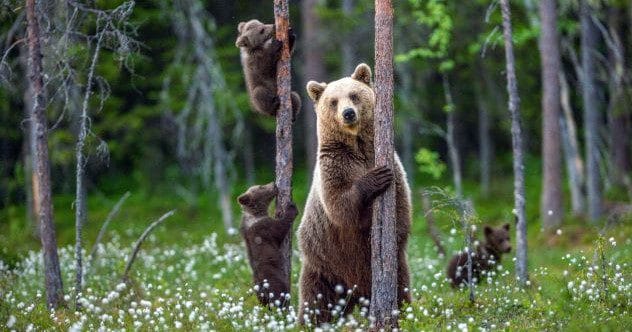Spending time in nature is wonderful, but it’s important to understand the behaviors of wild animals. Knowing how they act and react can be crucial for your safety. Too often, people are unaware of what to do when they encounter these unpredictable creatures.
As more of us explore hiking trails, national parks, and scenic areas, the chances of encountering wildlife increase. This guide offers essential insights into how to respond when you come across various animals in the wild.
These tips might be needed if you encounter a wild animal on a hike or safari. It’s always better to be prepared than to find yourself in a dangerous situation without knowing what to do.
10. Brown / Grizzly Bears
Brown bears and grizzly bears are incredibly powerful animals, often confused as the same. Grizzlies are technically a subspecies of brown bear (Ursus arctos horribilis). The distinction is regional: coastal bears are called brown bears, while inland ones are grizzlies.
When encountering humans, they often perform a “bluff charge,” running toward you but stopping short of attack, accompanied by huffing and jaw-popping sounds. This is meant to scare you, and it should!
These movements are a warning. It’s best to back away slowly and sideways, which is seen as less threatening. Never turn your back and run, as this can trigger a chase.
Never provoke a brown bear. If attacked, don’t fight back. Play dead by lying on your stomach and protecting your neck. This can convince the bear you’re not a threat, and it may lose interest.[1]
9. Black Bears
Black bears require a different approach than brown/grizzly bears. They are typically smaller and more skittish. Their behavior when spotted in the wild differs significantly.
Black bears often climb trees when scared, either seeking safety or protecting their food. In this case, let the bear climb and back away slowly and carefully to avoid danger.
Black bears rarely attack humans, but if they do, don’t play dead. Instead, try to escape to a secure location like a car or building. If escape isn’t possible, fight back with all your might.
Use sticks, stones, or any available object to strike the bear’s muzzle. This may stun it enough to scare it off. Black bears are generally more hesitant than brown bears, so fighting back can deter them.[2]
8. African Animals
If you find yourself on an African safari, knowing how to react to its animals is essential. Here’s a quick guide on what not to do.
Giraffes, though graceful, are strong and can be aggressive. They swing their necks to assert dominance, which can cause serious damage. Stay far away to avoid getting hit.
Elephants assert dominance by running at targets full speed but stopping just short of attacking. If this happens, walk away slowly without sudden movements to avoid being charged and trampled.
Male gorillas beat their chests and make aggressive noises to show dominance. Get away as quickly as possible, avoiding eye contact, which can trigger them.[3]
7. Fire Ants
Fire ants are known for their coordination and ability to sting en masse. Avoid them whenever possible.
Be wary of “ant rafts,” where hundreds of ants link together to form a floating mass. They do this to escape floods or dissuade predators.
During raft formation, fire ants are highly aggressive. If you see ants piling on each other, move in the opposite direction.[4]
6. Moose
Moose are powerful, large, and unpredictable. It’s best to keep a safe distance. They can inflict severe damage quickly if they turn on you.
Moose often lick things, including trees and cars, to mark their territory. Canadian officials advise residents to keep cars away from moose.
When a moose licks something, it’s claiming it as its own. This can lead to aggression if you try to move the object. Also, the more moose lick cars, the more they become habituated, increasing the risk of collisions.
Stay away from moose licking anything. It’s a territorial move, indicating you’re on their turf, which could lead to a confrontation. Licking means get lost![5]
5. Crows
When a large group of crows gathers, cawing and swooping, it’s called “mobbing.” This happens when they feel threatened, usually by a bird of prey or a human near their territory.
Mobbing is loud, aggressive, and chaotic. The mass effect can be intimidating. If you see it, leave the area.
Crows won’t chase you, so fleeing quickly reduces stress on the birds and stops the mobbing. You’ll avoid a real-life Hitchcock scene.[6]
4. Praying Mantis
The praying mantis is a fascinating creature that blends into its surroundings. It gets its name from its hunting posture, where it folds its forelimbs as if in prayer.
People aren’t mantis food, so there’s no need to worry about being attacked. Just leave it alone to continue its work.
Seeing a praying mantis is considered good luck. In many cultures, they represent health, wisdom, and wealth. If you see one and don’t disturb it, legend says you’ll have good fortune.[7]
5. Vultures
Vultures are large birds with impressive wingspans. They often perch on trees or rocks, sunbathing in the middle of the day, which can be a daunting sight.
They aren’t preparing to attack; they’re sunbathing to dry their wings, regulate body temperature, and get rid of parasites.
Sunlight disinfects and eliminates parasites from their feathers and skin folds. As observers, we can only watch in wonder.[8]
2. Jellyfish
Jellyfish are bioluminescent, emitting light in the water. They light up to scare predators or attract prey. If you see them glowing, give them space.
Bioluminescence is often a defense mechanism. Comb jellies use bright flashes to startle predators, while some species release glowing particles to confuse them.
When jellyfish glow, they are typically agitated and worried. Stay away to avoid heightening their stress. It might look beautiful, but it’s a fight for survival for them.[9]
1. Wolves
Hearing a wolf howl in the wilderness can be eerie, but it’s not as menacing as it seems. Wolves howl to communicate, not to hunt you.
They use howls to warn other wolves not to enter their territory or to check in with their pack. They howl out of affection, not anger or anxiety.
Wolves can be solitary, even in packs. They howl to reconnect with mates miles away. So, relax when you hear a wolf howl; it’s just saying, “Where are you? What are you up to? Wanna hang out later?” Enjoy the sounds without fear.[10]
Understanding the behaviors of wild animals is crucial for staying safe while enjoying nature. Whether it’s knowing how to react to a charging bear or recognizing the territorial signals of a moose, being informed can make all the difference.
Remember, respecting wildlife and understanding their actions ensures your safety and preserves their natural habitats. Stay informed, stay safe, and continue to appreciate the wonders of the natural world.
What are your experiences with wild animals? Share your stories and tips in the comments below!










